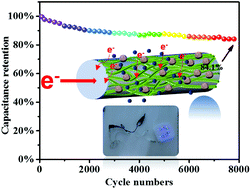MOF-derived Co9S8 polyhedrons on NiCo2S4 nanowires for high-performance hybrid supercapacitors†
Abstract
Herein, we reasonably designed MOF-derived Co9S8 polyhedrons coated on NiCo2S4 nanowire composites for high performance hybrid supercapacitors. The NiCo2S4 nanowires have one-dimensional structure that can provide better electronic transmission characteristics and Co9S8 polyhedrons modified on nanowires can further expand the contact surface area and increase active sites of the Faraday reaction. Besides, the proportion of components can be adjusted and optimized by controlling the reaction time. The synergistic effects between the two components significantly improve their pseudocapacitance. The test results indicated that the specific capacitance of the NiCo2S4/Co9S8 electrode with an optimal ratio can reach up to 2390.2 F g−1 (331.8 mA h g−1) at a current density of 1 A g−1. Even when the current density increased to 10 A g−1, its rate performance was still maintained at 88.2%. A hybrid supercapacitor was assembled with NiCo2S4/Co9S8 and activated carbon shows a high energy density of 47.7 W h kg−1 when the power density is 1275 W kg−1, as well as good cycle stability (84.1% capacitance retention after 8000 charging/discharging cycles). Therefore, this device has a potential practical space in portable energy storage devices.



 Please wait while we load your content...
Please wait while we load your content...